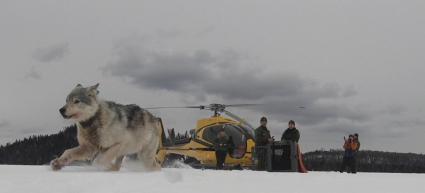New wolves at Isle Royale are reproducing, harvesting moose
Gray wolves that were taken to Michigan's Isle Royale National Park to rebuild its nearly extinct population are forming social groups and staking out territory — promising signs despite heavy losses from natural causes and deadly fights, scientists said Monday.
They've also achieved a primary goal of the reintroduction initiative by reducing the park's moose herd, which has become too big for its own good, researchers with Michigan Technological University said.
“They're having no trouble finding and preying on moose, and that's really significant,” said wildlife ecologist Rolf Peterson, who has spent decades studying the relationship between the two species on the Lake Superior island chain. “The signs are all positive, I think.”
Wolves are believed to have made their way to Isle Royale by crossing ice bridges from Minnesota or the Canadian province of Ontario in the mid-20th century. After becoming established, their numbers averaged in the 20s before declining sharply in the past decade, primarily due to inbreeding.
The National Park Service announced plans in 2018 to restore the population, which had fallen to two. Crews took 19 wolves from Minnesota, Ontario and Michigan's Upper Peninsula to the island in a series of airlifts. Some have died and at least one wandered back to the mainland.
Reports released Monday said the most recent tally, made by the Michigan Tech research team during low-altitude flights last winter, turned up 12 live wolves. Two others that had been seen previously were unaccounted for, meaning the population could be as high as 14.
Researchers counted 15 live wolves in 2019, when the first pup was believed to have been born to the new arrivals. It may have been conceived before its mother was taken to the island, Peterson said.
Four social groups appeared to be taking shape, displaying signs of courtship and willingness to mate, although they weren't sufficiently structured to be considered packs.
Two have staked out territories on opposite halves of the 45-mile-long park's main island, while the others were trying to establish secure areas to wander and hunt, spending considerable time on smaller islands.
The plan calls for 20 to 30 wolves to be taken to Isle Royale over three to five years, but the coronavirus pandemic has put additional relocations on hold, spokeswoman Liz Valencia said.
Tweet







